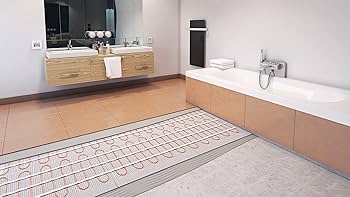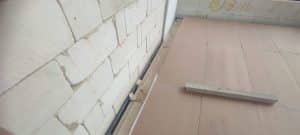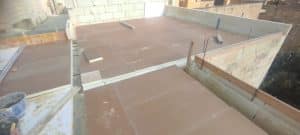When it comes to creating a comfortable, energy-efficient home in Malta, few upgrades can match the luxury and practicality of underfloor heating. Imagine stepping onto warm tiles on a chilly winter morning—pure bliss. But with comfort comes responsibility. Installing and operating such a system, especially under tiles, requires careful planning and adherence to best practices.
In this guide, we’ll explore the most important safety guidelines for underfloor heating with tiles so you can enjoy a warm home without worrying about damage, inefficiency, or safety hazards. Whether you’re a homeowner considering installation or already have a system in place, these tips will help protect your investment and keep your living space safe.
And if you’d rather leave it to the pros, you can always contact us here for expert installation and advice.
Understanding the Basics of Underfloor Heating with Tiles| Safety Guidelines for Underfloor Heating with Tiles
Before we dive into specific safety guidelines, it’s important to understand how tiled underfloor heating works. There are two main types:
Electric underfloor heating – Uses heating cables or mats placed beneath the tiles, connected to a thermostat for temperature control.
Water-based underfloor heating – Circulates warm water through pipes installed under the floor, powered by a boiler or heat pump.
Tiles—especially ceramic and porcelain—are an ideal choice for these systems because they’re excellent conductors of heat. However, they also require careful handling during installation and operation to avoid cracks, warping, or system damage.
For a deeper overview, you can also check out the general underfloor heating guide on Wikipedia.
1. Choose the Right Type of Tile for Safety and Efficiency| Safety Guidelines for Underfloor Heating with Tiles
The first safety guideline for underfloor heating with tiles is to select the correct tile material.
Porcelain and ceramic tiles are the top choices in Malta due to their durability and heat conductivity.
Natural stone tiles like marble or granite can also work well but require proper sealing to prevent moisture damage.
Avoid soft or porous materials like untreated limestone without a sealant, as they may crack or absorb water.
Why does this matter? Poor-quality or incompatible tiles can expand and contract unevenly when heated, leading to cracks that not only ruin your floor’s look but can also cause trip hazards or damage the heating system beneath.
💡 Pro Tip: Always check the manufacturer’s label for “underfloor heating compatible” before purchase.
2. Install a Proper Insulation Layer| Safety Guidelines for Underfloor Heating with Tiles
A key safety and efficiency measure is to include an insulation layer beneath the heating system.
Without proper insulation, heat can escape downwards into the subfloor instead of warming your home. This means the system works harder, increasing your electricity bills and the wear on the heating elements.
For tiled floors, insulation boards are often used to:
Direct heat upward for faster warm-up times.
Reduce thermal stress on the subfloor.
Protect against dampness and moisture ingress.
Given Malta’s mild but humid winters, moisture resistance is just as important as heat efficiency.
3. Hire a Qualified Installer| Safety Guidelines for Underfloor Heating with Tiles
DIY installation might sound tempting, but underfloor heating systems require precise electrical and tiling work. Improper installation is the leading cause of both safety hazards and system failures.
A qualified installer will:
Calculate the correct wattage or water flow for your space.
Ensure heating mats or pipes are laid evenly to prevent hot spots.
Select adhesives and grout that can handle thermal expansion.
Test the system before tiles are permanently set.
In Malta, hiring a professional usually costs between €25–€40 per square metre for electric systems, and more for water-based systems. Considering the cost of repairs if something goes wrong, it’s a smart investment.
4. Use Heat-Resistant Adhesives and Grout| Safety Guidelines for Underfloor Heating with Tiles
Not all tile adhesives and grout are created equal. Standard materials might weaken or crack when exposed to the constant heating and cooling cycles of an underfloor system.
For long-lasting and safe tiled underfloor heating:
Choose flexible, heat-resistant adhesives designed for underfloor heating.
Opt for polymer-modified grouts to accommodate slight tile movement.
These products prevent tiles from loosening and reduce the risk of gaps that can let moisture seep through to the heating system.
5. Set a Safe Maximum Temperature| Safety Guidelines for Underfloor Heating with Tiles
While it’s tempting to crank up the thermostat for quick warmth, excessive temperatures can damage both your tiles and the heating components.
For most tiled floors:
Keep surface temperatures at or below 27°C.
In bathrooms, you can go slightly higher, but never exceed 29°C.
Exceeding these limits can cause tile adhesive to weaken, tiles to crack, and in extreme cases, damage to electrical wiring or water pipes.
Modern thermostats often come with a floor temperature sensor—use it to maintain safe and consistent heating levels.
6. Avoid Drilling into Heated Floors| Safety Guidelines for Underfloor Heating with Tiles
This may sound obvious, but it’s a surprisingly common mistake. Drilling into a tiled floor with underfloor heating can puncture electric cables or water pipes, leading to costly repairs.
If you must install fixtures—like bathroom towel rails or kitchen islands—mark out heating zones in advance, and keep these areas clear of drilling.
A professional installer should provide a floor layout map showing where heating elements are located. Keep this document safe for future reference.
7. Schedule Regular Maintenance and Safety Checks| Safety Guidelines for Underfloor Heating with Tiles
Even though underfloor heating systems are generally low-maintenance, annual safety checks are still recommended.
For electric systems, checks include:
Testing electrical resistance of heating cables.
Inspecting thermostats and sensors.
For water-based systems, checks include:
Ensuring there are no leaks in the pipes.
Flushing the system to remove any build-up that could affect performance.
Maintenance costs in Malta typically range from €50–€100 per visit, depending on the system type.
Why Safety Guidelines for Underfloor Heating with Tiles Matter in Malta| Safety Guidelines for Underfloor Heating with Tiles
Malta’s climate is unique—it doesn’t get freezing cold, but damp, cool winters can make tiled floors uncomfortably cold. This makes underfloor heating a practical solution. However, moisture, salt air, and building materials common in Maltese homes require extra attention to detail.
By following these safety guidelines for underfloor heating with tiles, you’ll:
Extend the life of your heating system.
Reduce your energy bills.
Maintain the beauty and integrity of your tiled floors.
If you’d prefer to skip the trial and error, our experts can help design and install a system tailored to your home’s needs. Contact us here to learn more.
8. Allow Adequate Curing Time Before Switching On| Safety Guidelines for Underfloor Heating with Tiles
One of the most overlooked safety guidelines for underfloor heating with tiles is giving the floor enough time to fully cure after installation.
When tile adhesive or grout is still drying, switching on the heating too early can cause rapid moisture evaporation, leading to cracks in both the tiles and the grout. It can also weaken the bond between the tile and subfloor.
Recommended curing time in Malta’s climate:
Electric systems – Wait at least 7 days before turning the system on.
Water-based systems – Wait at least 2 weeks to ensure all mortar, screed, and adhesives are fully set.
Patience here will save you from costly repairs later.
9. Use Zoned Heating for Efficiency and Safety| Safety Guidelines for Underfloor Heating with Tiles
If your underfloor heating system covers multiple rooms, consider dividing it into heating “zones.”
Why it matters for safety:
Prevents overheating in smaller or more insulated rooms.
Reduces strain on the system, extending its lifespan.
Allows you to fine-tune comfort levels for different areas.
For example, your living room might need a slightly higher temperature than a sunlit kitchen, while bedrooms often require lower settings for better sleep quality.
Zoned systems may require a larger initial investment—about €200–€500 more depending on size—but they pay off quickly in reduced energy costs.
10. Protect the Floor from Heavy Impact and Scratches| Safety Guidelines for Underfloor Heating with Tiles
Tiled underfloor heating systems are durable, but they’re not invincible. Heavy impacts can crack tiles, and scratches can weaken their surface seal, allowing moisture to penetrate to the heating system below.
To protect your investment:
Use felt pads under furniture legs.
Avoid dropping heavy tools or appliances on the floor.
In kitchens, use mats near areas where pots or pans are handled.
These simple precautions help ensure your heating system remains safe and efficient for years.
11. Avoid Covering Heated Areas with Thick Rugs| Safety Guidelines for Underfloor Heating with Tiles
It’s tempting to throw down a thick, fluffy rug over your warm tiles, but doing so can trap heat and cause dangerous hotspots.
Thick rugs:
Restrict heat flow.
Increase system strain.
May cause tile adhesive to overheat and weaken.
If you must use rugs, choose low-tog (thin) ones labeled as underfloor heating safe. These allow heat to pass through while still adding comfort.
12. Be Aware of Expansion Joints
Expansion joints are small, deliberate gaps in the tiling that allow for natural thermal expansion and contraction.
For safety and system longevity:
Never cover or block expansion joints with adhesive or grout.
Ensure your installer has correctly placed them according to the floor size and tile type.
Ignoring expansion joints can cause tiles to lift or “tent,” a serious trip hazard and a risk to the heating elements beneath.
13. Know the Signs of a Problem Early| Safety Guidelines for Underfloor Heating with Tiles
Even with the best safety guidelines for underfloor heating with tiles, problems can occur. Spotting early warning signs can save you from expensive repairs:
Uneven heating – Could indicate a damaged heating element or blocked water pipe.
Unusual noises – Gurgling in water systems or buzzing in electric systems needs investigation.
Hot spots – Localised overheating could mean improper contact between tiles and the heating system.
If you notice any of these, switch off your system immediately and call a professional.
14. Combine with a Smart Thermostat for Safer Control| Safety Guidelines for Underfloor Heating with Tiles
Smart thermostats aren’t just about convenience—they can also enhance safety.
Advantages include:
Temperature limits – Prevents overheating automatically.
Scheduling – Reduces unnecessary operation, saving energy and lowering risk.
Remote monitoring – Lets you check and adjust your system even when you’re away from home.
In Malta, a decent smart thermostat for underfloor heating costs between €150–€300, but the long-term benefits make it worthwhile.
15. Keep Moisture Out of the System| Safety Guidelines for Underfloor Heating with Tiles
Moisture is a major enemy of both electric and water-based underfloor heating systems. In electric systems, it can cause short circuits; in water systems, it can promote corrosion or bacterial growth.
For tiled floors:
Ensure grout lines are sealed.
Reapply sealant as recommended (usually every 1–2 years).
Address leaks or spills promptly, especially in kitchens and bathrooms.
16. Follow the Manufacturer’s Safety Guidelines| Safety Guidelines for Underfloor Heating with Tiles
Every underfloor heating product comes with specific instructions from the manufacturer—adhere to them strictly.
This includes:
Recommended operating temperatures.
Approved adhesives and grouts.
Maintenance schedules.
Following these ensures your system remains within warranty and operates as intended.
17. Consider Professional Annual Inspections
While we touched on maintenance earlier, professional inspections deserve a separate mention.
An expert will:
Check electrical resistance and insulation.
Inspect thermostats for accuracy.
Examine tiles for cracks or lifted edges.
Annual inspections in Malta typically cost €50–€120, depending on system complexity. This small expense can prevent far greater costs down the road.
The Cost of Not Following Safety Guidelines
Skipping safety steps can lead to:
Tile cracks costing €20–€50 per tile to replace.
Electrical faults requiring €300–€700 in repairs.
Full system replacement costs ranging from €1,500–€5,000, depending on the size and type.
When compared to these potential costs, following the safety guidelines for underfloor heating with tiles is a no-brainer.
Final Thoughts: Comfort Without Compromise
Underfloor heating with tiles is one of the best ways to combine comfort, style, and energy efficiency in Malta’s unique climate. But the key to long-term enjoyment is safety—both during installation and throughout its lifetime.
By following these safety guidelines for underfloor heating with tiles, you’ll ensure:
A warm, welcoming home.
Lower long-term energy and repair costs.
Peace of mind knowing your system is safe for your family.
If you’re ready to upgrade your home with a professionally installed, safe, and efficient underfloor heating system, we’re here to help.
📞 Contact Us
For expert advice and installation services in Malta, contact us here. Our experienced team will ensure your system meets the highest safety and performance standards.
🔧 Check Out Our Service
Want to learn more about installing underfloor heating on tiles? Check out our service here to see how we can bring year-round comfort to your home.
Outbound Reference
For a more general understanding of how these systems work, visit this underfloor heating overview.




